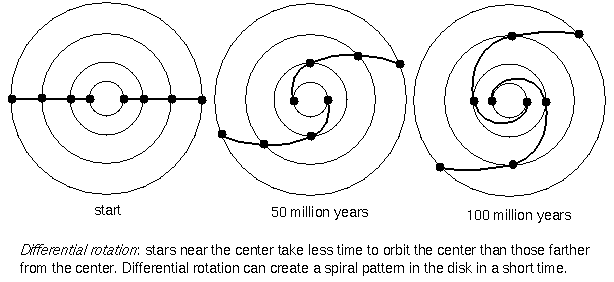
This material (including images) is copyrighted!. See my copyright notice for fair use practices. Select the photographs to display the original source in another window. The ground-based telescope pictures here are from the Anglo-Australian Observatory (AAO---used by permission). Links to external sites will be displayed in another window.
The stars and gas and dust clouds in the disk congregate in a spiral pattern. There are four parts to the spiral pattern in our Galaxy called spiral arms. There are many stars that are also in-between the spiral arms, but they tend to be the dimmer stars (G, K, M-type stars). Long-lived stars will move in and out of the spiral arms as they orbit the galaxy. Star formation occurs in the spiral arms because the gas clouds are compressed in the arms to form stars. The very luminous, short-lived O and B-stars and H II regions around them enhance the spiral outline. They outline the spiral pattern the same way Christmas lights around the edges of a house will outline the borders of the house at night. The O and B-type stars live for only a few million years, not long enough to move outside of a spiral arm. That is why they are found exclusively in the spiral arms.

Differential rotation provides an easy way to produce a spiral pattern in the disk. Differential rotation is the difference in the angular speeds of different parts of the galactic disk so stars closer to the center complete a greater fraction of their orbit in a given time. But differential rotation is too efficient in making the spiral arms. After only 500 million years, the arms should be so wound up that the structure disappears. Also, the spiral pattern should occupy only a small part of the disk. The observations of other galaxies contradicts this: the spiral arms in spiral galaxies rarely have more than two turns. Galaxies are billions of years old so the spiral pattern must be a long-lasting feature. What maintains the spiral pattern?
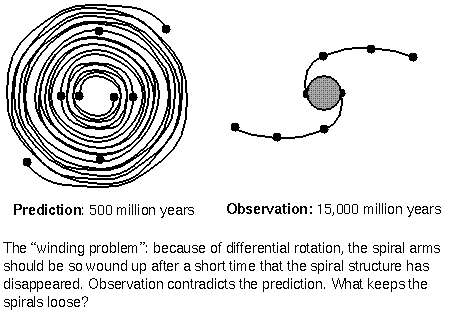
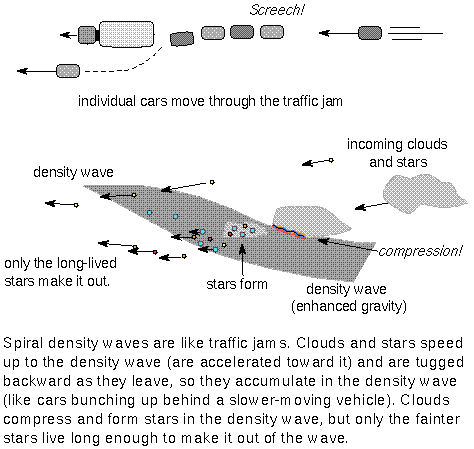
In a galaxy the spiral region of greater gravity concentrates the stars and gas. The spiral regions rotate about as half as fast as the stars move. Stars behind the region of greater gravity are pulled forward into the region and speed up. Stars leaving the region of greater gravity are pulled backward and slow down. Gas entering spiral wave is compressed. On the downstream side of wave, there should be lots of H II regions (star formation regions). This is seen in some galaxies with prominent two-armed spiral patterns. But there are some unanswered questions. What forms the spiral wave in the first place? What maintains the wave?
Computer simulations of galaxy disks with a series of supernova explosions do produce spiral arms but they are ragged and not as symmetrical and full as seen in so-called ``grand-design'' spirals that have two arms. There are spiral galaxies with numerous, ragged spiral arms in their disks (called ``flocculent'' spirals), so perhaps the self-propagating star formation mechanism is responsible for the flocculent spirals.
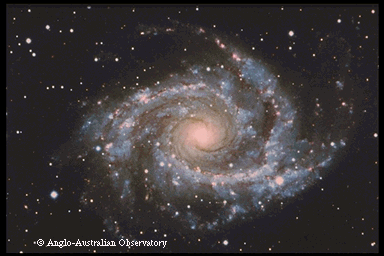 A ``grand-design''spiral seen face-on. |
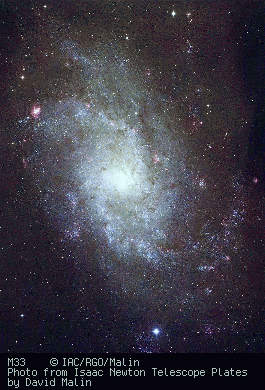 A flocculent spiral with ragged spiral arms. |
![]() Go back to previous section --
Go back to previous section --
![]() Go to next section
Go to next section
last updated: June 27, 2022